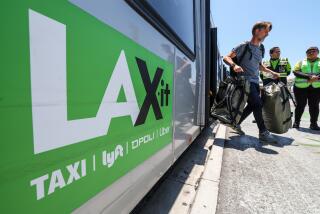THE MTA STRIKE : Ride-Sharing Helps Avert Major Workplace Disruptions : Impact: Few businesses report major problems, in part because of programs designed to get employees to work in a disaster. However, many bus riders worry about hardships from a long walkout.
- Share via
Some employees arrived late or not at all and customers were scarce at some establishments, but most Los Angeles area workers and businesses made it through Monday’s first day of a regional bus strike with only minor disruptions or lost revenues.
Ride-sharing programs--set up to get employees to work in the event of an earthquake or other disaster--went a long way toward alleviating potential disruptions as a strike crippled much of the Metropolitan Transportation Authority and its fleet of 1,900 buses. In addition, Monday is a relatively slow day for retailers, minimizing any potential drop in sales.
But the walkout by MTA mechanics, which was honored by drivers and clerks, struck a quick and costly blow at some businesses. The strike could also prove a financial burden to many bus riders because many companies will not pay them for lost hours.
In Downtown Los Angeles at Clifton’s Cafeteria on Broadway, where the predominantly Latino clientele is heavily dependent on mass transit, only 450 of the normal 700 customers showed up for breakfast, said manager Jose Morales. The lunch crowd at the three-level restaurant was reduced by more than 30%, and Morales said Monday afternoon that he might close early if evening traffic remained light.
“It’s really hurting,” Morales said, adding that he might have to reduce workers’ hours substantially if business does not improve.
Shopping traffic at the Glendale Galleria, however, seemed on target to match the usual Monday average of 35,000 to 50,000 shoppers, said Nicolette Abernathy, marketing director for the mall. Although she had no statistics about the number of Galleria shoppers that rely on public transportation, Abernathy said the strike could have a more serious impact on retailers if it continues through the weekend.
More than a quarter of a million people in Los Angeles County rely on mass transit to get to work, and countless more use MTA buses for shopping.
“Just about every business with transit-dependent employees will feel some impact from the strike, but we don’t anticipate a severe economic impact,” said Shannon Jones of the Los Angeles Area Chamber of Commerce.
Employees at Southern California Gas Co. reported “no major problems” getting to work Monday, said company spokesman George McQuade. The company made arrangements for those stranded by the strike to drive to work and park free at a garage near the company’s Downtown offices and catch a shuttle bus. With 42 van pools and 170 car pools, it was easy for workers to bum a ride from fellow employees, McQuade said.
“It’s just been a little inconvenient,” McQuade said. “A lot of people complained that buses were overcrowded. One guy hitched a ride when he was stranded at his bus stop on Wilshire.”
Jim Hart, a spokesman for Northrop Grumman in Century City, said he hadn’t noticed any difference in employee attendance Monday.
“We have a lot of ride-share people, and we are providing match lists for bus riders to latch onto car pools and van pools,” Hart said. “A few people have asked about it, but the numbers aren’t that big.”
Only three of the 690 workers at the Los Angeles Airport Marriott failed to show up for work on Monday because of the strike, said Marriott spokeswoman Catherine Boire. Employees who cannot find a way to their job will be given the day off--but without pay, Boire said.
Lisa Mattis, an operator at the Westin Bonaventure Hotel in Downtown Los Angeles, has been taking the bus to work for 27 years. She arrived at work two hours late on Monday, but she said her supervisor was “very understanding.”
“It’s very unfair that those of us who are working poor are going to suffer,” she said.
More to Read
Sign up for Essential California
The most important California stories and recommendations in your inbox every morning.
You may occasionally receive promotional content from the Los Angeles Times.













